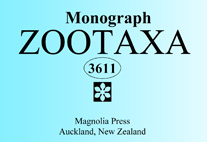Abstract
The family Listropsoralgidae Fain, 1965 (Acariformes: Sarcoptoidea) is represented by the permanent skin ectoparasites associated with the South American and Australian marsupials (12 species) and the South American rodents of the family Echimyidae (1 species). The phylogenetic relationships of these mites (12 ingroup and 2 outgroup species) are reconstructed on the basis of the maximum parsimony (MP) and Bayesian analyses (BA) of 76 morphological characters. MP analysis confirmed monophyly of the listropsoralgid genera, the strict consensus of 18 trees generated by MP has the following pattern: Petauralges (Listropsoralgoides, Didelphialges, Listropsoralges) with poor resolution among species of the genus Listropsoralges. The same tree was generated by BA. Both successive and implied weighting strategies resulted in 7 MP trees: Petauralges (Listropsoralgoides (Didelphialges (Listropsoralges))). The relationships between species of the genus Listropsoralges received the poorest resolution: L. caenolestes (L. monodelphis, L. vossi, L. faini, L. brevisetosa (L. thylamys (L. marmosa–L. caluromys))). The host-parasite relationships of listropsoralgids are briefly discussed. The family Listropsoralgidae is taxonomically revised and to date includes 13 species in 4 genera. Six species and one genus are described as new: Listropsoralges brevisetosus sp. n. from Marmosa murina (Didelphimorphia: Didelphidae) from Peru, Listropsoralges similis sp. n. from Caluromys derbianus (Didelphidae) from Panama, Listropsoralges thylamys sp. n. from Thylamys venustus (Didelphidae) from Bolivia, Listropsoralges vossi sp. n. from Monodelphis domestica (Didelphidae) from Brazil, Listropsoralges caenolestes sp. n. from Caenolestes fuliginosus (Paucituberculata: Caenolestidae) from Ecuador, and Didelphialges metachirus gen. n., sp. n. from Metachirus nudicaudatus (Didelphidae) from Peru. The female of Listropsoralges faini Bochkov and Wauthy, 2009 is described for the first time.
References
Andre, H.M. (1988) Age-dependent evolution: from theory to practice. In: Humphries, C.-J. (Ed.). Ontogeny and Systematics. Columbia University Press, New York, USA. pp. 137–187.
Andre, H.M. & Fain, A. (2000) Phylogeny, ontogeny and adaptive radiation in the superfamily Tydeoidea (Acari: Actinedida), with a reappraisal of morphological characters. Zoological Journal of the Linnean Society, 130, 405–448. http://dx.doi.org/10.1111/j.1096-3642.2000.tb01636.x
Asher, R.J., Horovitz, I. & Saґnchez-Villagra, M.R. (2004) First combined cladistic analysis of marsupial mammal interrelationships. Molecular Phylogenetics and Evolution, 33, 240–250. http://dx.doi.org/10.1016/j.ympev.2004.05.004
Bochkov, A.V. (2007) Morphological adaptations of acariform mites to permanent parasitism on mammals. Parazitologiya, 41, 428–458. [In Russian]
Bochkov, A.V. (2010) A review of mammal associated Psoroptidia (Acariformes: Astigmata). Acarina, 18, 99–260.
Bochkov, A.V. & Mironov, S.V. (2011)Phylogeny of mammal-associated psoroptidian mites (Acariformes: Astigmata: Psoroptidia): view of morphologists. Invertebrate Systematics, 25, 22–59. http://dx.doi.org/10.1071/IS10023
Bochkov, A.V. & Wauthy, G. (2009) A review of the genus Listropsoralges (Acari, Psoroptidae) with the descriptions of two new species. Acta Parasitologica, 54, 269–275. http://dx.doi.org/10.2478/s11686-009-0042-2
Domrow, R. (1988) Petauralges mordax sp. n. (Acari: Psoroptidae) from an Australian dasyurid marsupial. Journal of the Australian Entomological Society, 27, 87–90. http://dx.doi.org/10.1111/j.1440-6055.1988.tb01152.x
Domrow, R. (1992) Acari Astigmata (excluding feather mites) parasitic on Australian vertebrates: an annotated checklist, keys and bibliography. Invertebrate Taxonomy, 6, 1459–1606. http://dx.doi.org/10.1071/IT9921459
Fain, A. (1965) Les acariens producteurs de gale chez les edentes et les marsupiaux (Psoroptidae et Lobalgidae: Sarcoptiformes). Bulletin de Institut royal des Sciences Naturelles de Belgique, 41, 1–41.
Fain, A. & Lukoschus, F.S. (1970) Parasitic mites of Suriname II. Skin and fur mites of the families Psoroptidae and Lobalgidae. Acta Zoologica et Pathologica Antverpensia, 51, 49–60.
Fain, A. & Lukoschus, F.S. (1979) Two new parasitic mites (Acari, Astigmata) from the skin of Australian vertebrates. Mitteilungen aus dem Hamburgischen Zoologischen Museum und lnstitut, 76, 387–93.
Farris, J.S. (1969) A successive approximations approach to character weighting. Systematic Zoology, 18, 374–385. http://dx.doi.org/10.2307/2412182
Goloboff, P. (1993) Estimating character weightings during tree search. Cladistics, 9, 83–91. http://dx.doi.org/10.1111/j.1096-0031.1993.tb00209.x
Grandjean, F. (1941) La сhaetotaxie comparee des pattes chez las oribates (ire serie). Bulletin Societe Zoology France, 66, 33–50.
Griffiths, D.A., Atyeo, W.T., Norton, R.A. & Lynch, C.A. (1990) The idiosomal chaetotaxy of astigmatid mites. Journal of Zoology (London), 220, 1–32. http://dx.doi.org/10.1111/j.1469-7998.1990.tb04291.x
Gutierrez, E.E., Jansa, S.A. & Voss, R.S. (2010) Molecular systematics of mouse opossums (Didelphidae: Marmosa): assessing species limits using mitochondrial DNA sequences, with comments on phylogenetic relationships and biogeography. American Museum Novitates, 3692, 1–22. http://dx.doi.org/10.1206/708.1
Mironov, S.V., Bochkov, A.V. & Fain, A. (2005) Phylogeny and evolution of parasitism in feather mites of the families Epidermoptidae and Dermationidae (Acari: Analgoidea). Zoologischer Anzeiger, 243, 155–179. http://dx.doi.org/10.1016/j.jcz.2004.10.001
Muller, K (2004) PRAP - computation of Bremer support for large data sets. Molecular Phylogenetics and Evolution, 31, 780–782. http://dx.doi.org/10.1016/j.ympev.2003.12.006
Nixon, K.C. (1999) WinClada. Version 0.9. 0.9.99m24. Ithaca, New York, USA.
Norton, R. (1998) Morphological evidence for the evolutionary origin of Astigmata (Acari: Acariformes). Experimental & Applied Acarology, 22, 559–594. http://dx.doi.org/10.1023/A:1006135509248
OConnor, B.M. (1982) Astigmata. In: Parker, S.P. (Ed.). Synopsis and Classification of Living Organisms. Vol. 2. McGraw-Hill Book Company, New York, USA: pp. 146–169.
OConnor, B.M. (2009) Cohort Astigmatina. In: Krantz G.W., Walter D.E. (Eds.). A Manual of Acarology. 3rd ed. Texas Tech University Press, Lubbock, Texas, USA, pp. 565–657.
Page, R.D.M. (1998) TreeView 1.5.2. University of Glasgow, Glasgow, UK.
Page, R.D.M. (2001) NDE: NEXUS Data Editor 0.5.0. University of Glasgow, Glasgow, UK.
Ronquist, F., Huelsenbeck, J. & Teslenko, M. (2011) MrBayes version 3.2 Manual: Tutorials and Model Summarie.
Swofford, D.L. (2001) PAUP*: Phylogenetic Analysis Using Parsimony (* and Other Methods). Version 4.’Sinauer Associates, Sunderland, Massachusetts, USA.
Trueman, J.W.H. 1998. Reverse successive weighting. Systematic Biology, 47, 733–737. http://dx.doi.org/10.1080/106351598260725
Voss, R.S. & Jansa, S.A. (2009) Phylogenetic relationships and classification of didelphid marsupials, an extant radiation of New World metatherian mammals. Bulletin of the American Museum of Natural History, 322, 1–177. http://dx.doi.org/10.1206/322.1
Wilson, D.E. & Reeder, D.M. (2005) Mammal species of the world. A taxonomic and geographic reference. 3rd ed. The Johns Hopkins University Press, Baltimore, 2142 pp.

